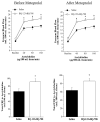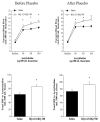Chronic Nebivolol Treatment Suppresses Endothelin-1-Mediated Vasoconstrictor Tone in Adults With Elevated Blood Pressure
- PMID: 27113048
- PMCID: PMC4871319
- DOI: 10.1161/HYPERTENSIONAHA.115.06979
Chronic Nebivolol Treatment Suppresses Endothelin-1-Mediated Vasoconstrictor Tone in Adults With Elevated Blood Pressure
Abstract
Endothelin-1 (ET-1) plays a major role in the pathophysiology of hypertension and its associated cardiovascular risk. We tested the hypothesis that chronic nebivolol treatment reduces ET-1-mediated vasoconstrictor tone in adult humans with elevated blood pressure (BP). Furthermore, reducing ET-1 vasoconstrictor activity contributes to the improvement in endothelial vasodilator function associated with nebivolol treatment. Forty-two middle-aged adults with elevated BP (systolic BP ≥130 mm Hg or diastolic BP ≥85 mm Hg) completed a 3-month, double-blind, randomized, placebo controlled trial: 14 received nebivolol (8 men/6 women; 5 mg per day); 14 received metoprolol succinate (9 men/5 women; 100 mg per day); and 14 received placebo (9 men/5 women). Forearm blood flow (plethysmography) responses to selective (BQ-123: 100 nmol/min; 60 minutes) and nonselective (BQ-123+BQ-788 [50 nmol/min]; 60 minutes) ET-1 receptor blockade, as well as acetylcholine (4.0, 8.0, and 16.0 μg per 100 mL of tissue per minute) in the absence and presence of nonselective ET-1 receptor blockade were determined before and after each treatment intervention. Forearm blood flow responses to BQ-123 and BQ-123+BQ-788 were similarly and significantly elevated (≈30% and 60%, respectively) from baseline in all 3 groups. Nebivolol, but not metoprolol or placebo, therapy resulted in a marked (≈25% and 45%; P<0.05) reduction in forearm blood flow response to BQ-123 and BQ-123+BQ-788. Moreover, after nebivolol therapy only, vasodilator response to acetylcholine was not significantly increased by ET-1 receptor blockade. These results demonstrate that nebivolol, but not metoprolol, treatment reduces ET-1-mediated vasoconstrictor tone in adult humans with elevated BP. In addition, nebivolol-induced reduction in ET-1-mediated vasoconstrictor tone underlies the favorable effects of this β-blocker on endothelial vasodilation.
Clinical trial registration: URL: http://www.clinicaltrials.gov. Unique identifier: NCT01395329.
Keywords: blood pressure; endothelin-1; metoprolol; nebivolol; vasoconstriction.
© 2016 American Heart Association, Inc.
Figures






Similar articles
-
Elevated endothelin-1 vasoconstrictor tone in prehypertensive adults.Can J Cardiol. 2012 May;28(3):347-53. doi: 10.1016/j.cjca.2011.11.006. Epub 2012 Jan 14. Can J Cardiol. 2012. PMID: 22244775
-
Regular aerobic exercise reduces endothelin-1-mediated vasoconstrictor tone in overweight and obese adults.Exp Physiol. 2017 Sep 1;102(9):1133-1142. doi: 10.1113/EP086454. Epub 2017 Jul 16. Exp Physiol. 2017. PMID: 28635124
-
Nebivolol, But Not Metoprolol, Treatment Improves Endothelial Fibrinolytic Capacity in Adults With Elevated Blood Pressure.J Am Heart Assoc. 2017 Nov 9;6(11):e007437. doi: 10.1161/JAHA.117.007437. J Am Heart Assoc. 2017. PMID: 29122812 Free PMC article.
-
Role of nebivolol in the control and management of central aortic blood pressure in hypertensive patients.J Hum Hypertens. 2017 Oct;31(10):605-610. doi: 10.1038/jhh.2017.26. Epub 2017 Apr 6. J Hum Hypertens. 2017. PMID: 28382958 Review.
-
A Review of Nebivolol Pharmacology and Clinical Evidence.Drugs. 2015 Aug;75(12):1349-71. doi: 10.1007/s40265-015-0435-5. Drugs. 2015. PMID: 26177892 Free PMC article. Review.
Cited by
-
Effect of nebivolol or atenolol vs. placebo on cardiovascular health in subjects with borderline blood pressure: the EVIDENCE study.J Hum Hypertens. 2017 Dec;32(1):20-25. doi: 10.1038/s41371-017-0019-9. Epub 2017 Nov 28. J Hum Hypertens. 2017. PMID: 29184167 Clinical Trial.
-
Protective Effects of the Third Generation Vasodilatory Βeta - Blocker Nebivolol against D-Galactosamine - Induced Hepatorenal Syndrome in Rats.Open Access Maced J Med Sci. 2017 Dec 13;5(7):880-892. doi: 10.3889/oamjms.2017.173. eCollection 2017 Dec 15. Open Access Maced J Med Sci. 2017. PMID: 29362613 Free PMC article.
-
Chronic Elevation of Endothelin-1 Alone May Not Be Sufficient to Impair Endothelium-Dependent Relaxation.Hypertension. 2019 Dec;74(6):1409-1419. doi: 10.1161/HYPERTENSIONAHA.119.13676. Epub 2019 Oct 21. Hypertension. 2019. PMID: 31630572 Free PMC article.
-
Treatment With Endothelin-A Receptor Antagonist BQ123 Attenuates Acute Inflammation in Mice Through T-Cell-Dependent Polymorphonuclear Myeloid-Derived Suppressor Cell Activation.Front Immunol. 2021 Mar 22;12:641874. doi: 10.3389/fimmu.2021.641874. eCollection 2021. Front Immunol. 2021. PMID: 33828553 Free PMC article.
-
Effects of nebivolol versus other antihypertensive drugs on the endothelial dysfunction in patients with essential hypertension.Biosci Rep. 2020 May 29;40(5):BSR20200436. doi: 10.1042/BSR20200436. Biosci Rep. 2020. PMID: 32342981 Free PMC article. Review.
References
-
- Yanagisawa M, Hurihara H, Kimura S, Tomobe Y, Kobayashi M, Mitsui Y, Yazaki Y, Goto K, Masaki T. A novel potent vasoconstrictor peptide produced by vascular endothelial cells. Nature. 1988;332:411–415. - PubMed
-
- Haynes W, Strachan F, Gray G, Webb D. Forearm vasoconstriction to endothelin-1 is mediated by ETA and ETB receptors in vivo in humans. J Cardiovasc Pharmacol. 1995;26:S40–43. - PubMed
-
- Dashwood M, Tsui J. Endothelin-1 and atherosclerossis: potnetial complications associated with endothelin-receptor blockade. Atherosclerosis. 2002;160:297–304. - PubMed
-
- Masaki T, Kimura S, Yanagisawa M, Goto K. Molecular and cellular mechanism of endothelin regulation. Implications for vascular function. Circulation. 1991;89:1457–1468. - PubMed
-
- Taddei S, Virdis A, Ghiadoni L, Salvetti G, Bernini G, Magagna A, Salvetti A. Age-related reduction of NO availability and oxidative stress in humans. Hypertension. 2001;38:274–279. - PubMed
Publication types
MeSH terms
Substances
Associated data
Grants and funding
LinkOut - more resources
Full Text Sources
Other Literature Sources
Medical

